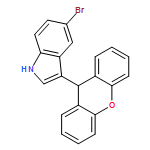Co-reporter:Zhen-Hua Ma, Huan-Rong Li, Han-Yuan Gong
Tetrahedron 2017 Volume 73, Issue 23(Issue 23) pp:
Publication Date(Web):8 June 2017
DOI:10.1016/j.tet.2017.04.059
The molecular box, namely cyclo[2](2,6-di(1H-imidazol-1-yl)pyridine)-[2](1,4-dimethylene benzene) (14+; as PF6− salt), fold its conformation as molecular tweezer to clip the specific carboxylates with expanded aromatic plane. The binding modes between 14+ and carboxylate, namely pseudorotaxane, outside or clipping (i.e., sandwich like), also depend on the location of carboxylate on the large conjugated moiety. These finding develop the usability of 14+ and carboxylates as important building block pairs to create non-covalent self-assembly structures.Download high-res image (161KB)Download full-size image
Co-reporter:Yali Li;Lingjuan Zhang;Zongyao Zhang;Jianbin Xu;Yixiao Pan;Conghui Xu;Lingxian Liu;Zengguang Li;Zhiyong Yu;Lijin Xu
Advanced Synthesis & Catalysis 2016 Volume 358( Issue 13) pp:2148-2155
Publication Date(Web):
DOI:10.1002/adsc.201600165
Co-reporter:Lingjuan Zhang, Ruiying Qiu, Xiao Xue, Yixiao Pan, Conghui Xu, Doudou Wang, Xinyu Wang, Lijin Xu and Huanrong Li
Chemical Communications 2014 vol. 50(Issue 82) pp:12385-12388
Publication Date(Web):28 Aug 2014
DOI:10.1039/C4CC06036A
A general and efficient Rh(I)-catalyzed decarbonylative direct C2-olefination of indoles with vinyl carboxylic acids has been developed. The reaction exhibits excellent functional group tolerance, regioselectivity and stereoselectivity, giving a broad range of C2-alkenylated indoles in good to excellent yields.
Co-reporter:Lingjuan Zhang;Xiao Xue;Conghui Xu;Yixiao Pan;Guang Zhang; Lijin Xu; Huanrong Li; Zhangjie Shi
ChemCatChem 2014 Volume 6( Issue 11) pp:
Publication Date(Web):
DOI:10.1002/cctc.201490063
Co-reporter:Lingjuan Zhang;Xiao Xue;Conghui Xu;Yixiao Pan;Guang Zhang; Lijin Xu; Huanrong Li; Zhangjie Shi
ChemCatChem 2014 Volume 6( Issue 11) pp:3069-3074
Publication Date(Web):
DOI:10.1002/cctc.201402534
Abstract
A RhI-catalyzed direct C2-arylation of indoles with diversely substituted aryl carboxylic acids has been developed using 2-pyrimidyl group as an easily installable and readily removable N-directing group. The reaction proceeded smoothly without the need for any external oxidants under relatively mild conditions to produce the C2-arylated indoles in high yields with excellent regioselectivity. A range of functional groups in both coupling partners were tolerated regardless of their electronic properties and positions. With the assistance of the 2-pyrimidyl group, these C2-functionalized products could further undergo C7-arylation to give the C7-aryl indole products. Mechanistic evidence supports that the reaction involves a decarbonylation step, and the carboxylic acids could be activated in situ by treatment with (tBuCO)2O to generate the active anhydrides.
Co-reporter:Huanrong Li, Zhiping Li, Zhangjie Shi
Tetrahedron 2009 65(9) pp: 1856-1858
Publication Date(Web):
DOI:10.1016/j.tet.2008.12.055
Co-reporter:Lingjuan Zhang, Ruiying Qiu, Xiao Xue, Yixiao Pan, Conghui Xu, Doudou Wang, Xinyu Wang, Lijin Xu and Huanrong Li
Chemical Communications 2014 - vol. 50(Issue 82) pp:NaN12388-12388
Publication Date(Web):2014/08/28
DOI:10.1039/C4CC06036A
A general and efficient Rh(I)-catalyzed decarbonylative direct C2-olefination of indoles with vinyl carboxylic acids has been developed. The reaction exhibits excellent functional group tolerance, regioselectivity and stereoselectivity, giving a broad range of C2-alkenylated indoles in good to excellent yields.





















